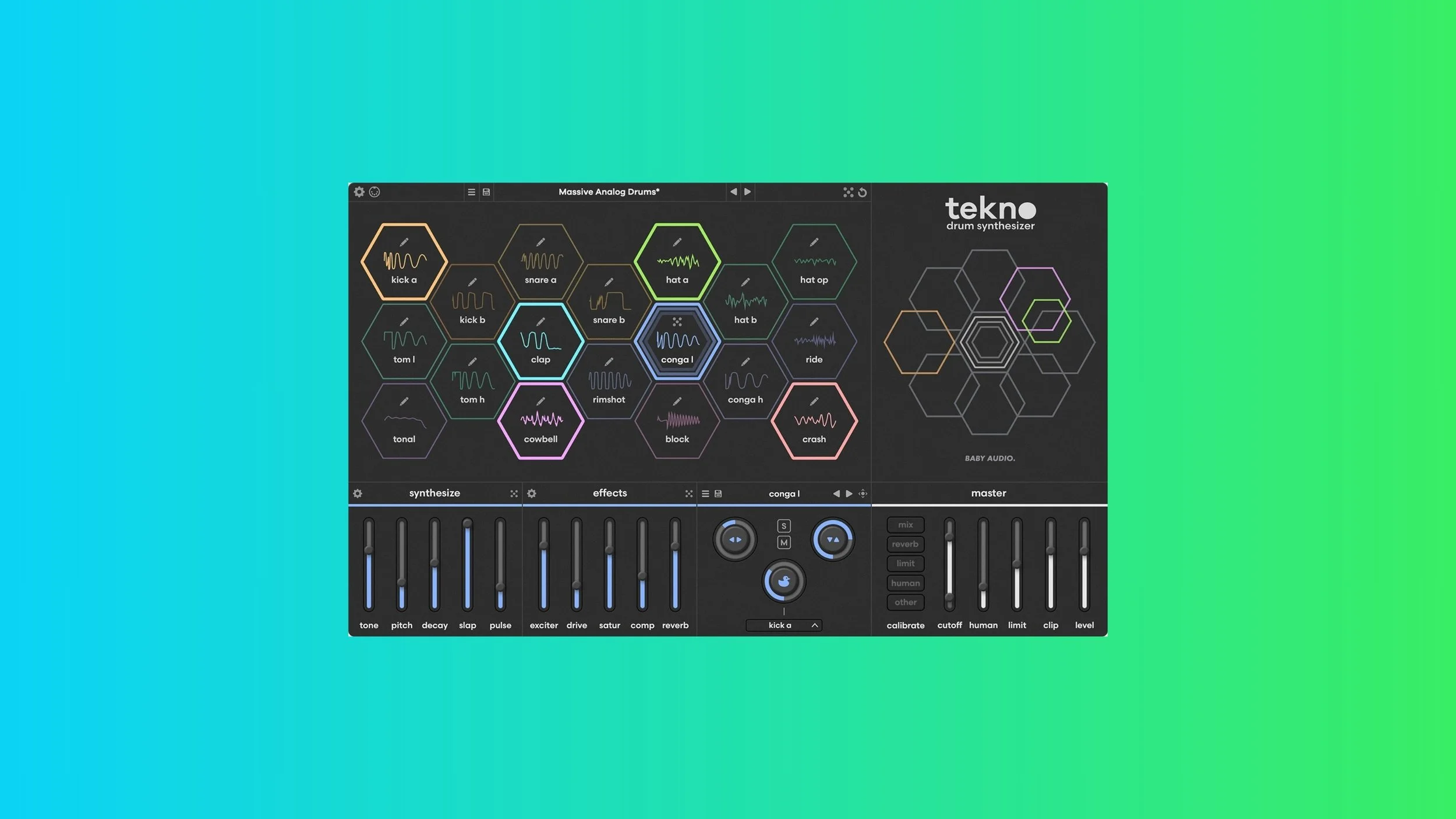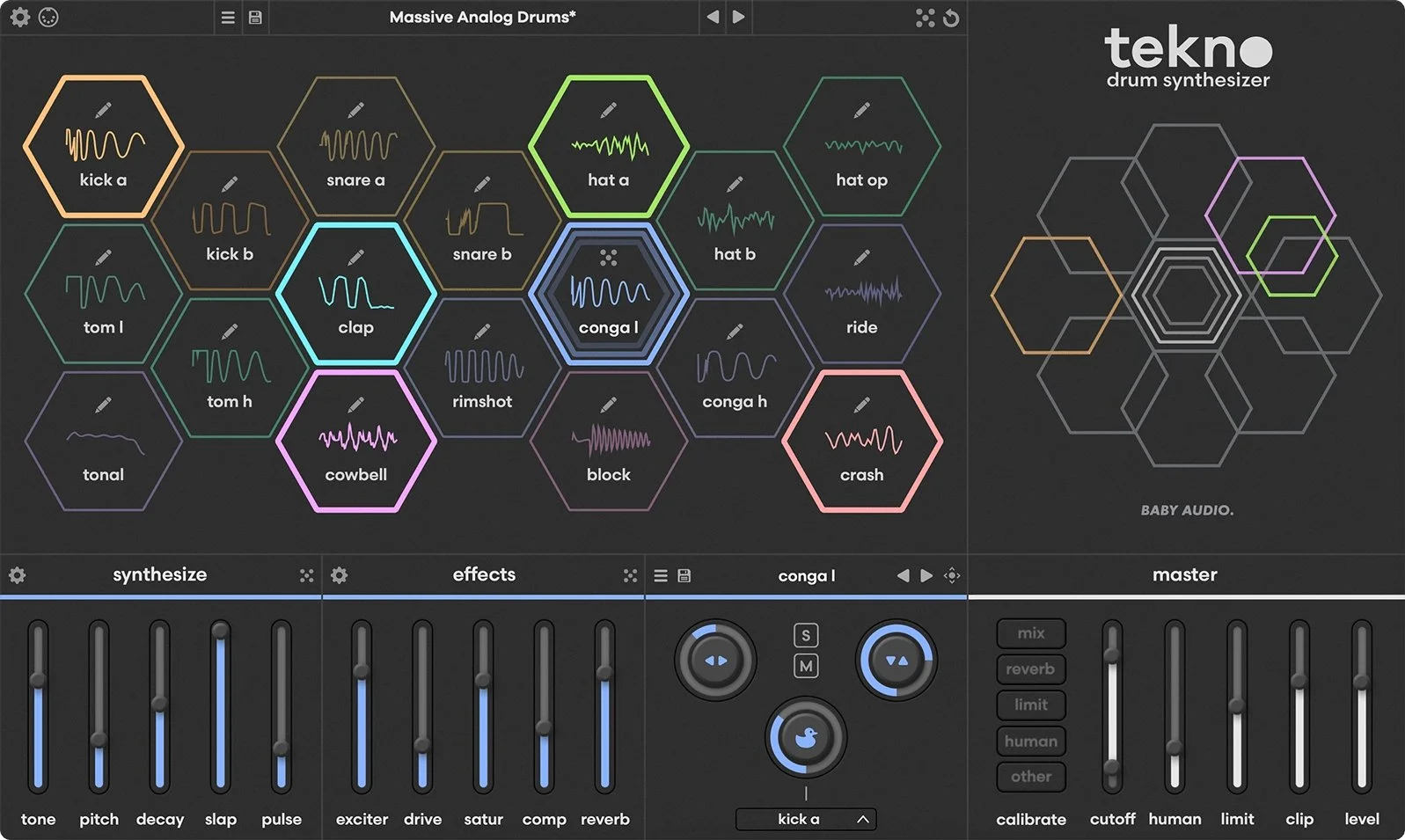Tekno by Baby Audio: The Drum Synth Built for Producers Who Hate Samples

When Baby Audio drops something new, the producer world pays attention — and with Tekno, they’re going after the drum machine itself. Instead of giving you another sample pack in plugin form, Tekno is a fully synthesized drum instrument with 18 engines covering everything from kicks and snares to tonal hits and FX. It’s bold, loud, and unapologetically digital — but in a way that feels fresh compared to the endless recycled 808 libraries floating around. On the surface, Tekno looks like a sleek modern drum machine with pads, effects, and a big preset bank. But underneath, it’s doing something most plugins don’t: it builds every hit from scratch, with non-linear circuit behavior that makes each sound slightly different. That gives it a raw, “alive” quality that sits somewhere between classic drum computers and modern modular experiments. In this post, we’ll break down what Tekno does, how it fits into a producer’s workflow, and whether it lives up to Baby Audio’s reputation for turning plugins into creative weapons.
This site contains affiliate links. If you book or purchase through these links, I may earn a commission at no extra cost to you. This helps support the site and keeps my content free. As an Amazon Associate, I earn from qualifying purchases.
What’s Tekno?
At its core, Tekno is a drum synthesizer plugin built entirely around generating sounds from scratch. Instead of drawing from sample banks or layering prerecorded hits, it gives you 18 different drum engines, each designed to handle a specific percussive role. You get the expected essentials — kicks, snares, hats, toms — but also more unusual slots for tonal percussion and abstract hits. The result is an instrument that feels closer to a digital drum machine with modular DNA than a typical plugin drum rack.
The synthesis under the hood is a hybrid of virtual analog, FM, and digital modeling, which makes it versatile enough to cover booming low-end, sharp transients, and weird synthetic textures. Baby Audio has leaned into the non-linear behavior of classic circuits, so every hit carries subtle variations in timbre and energy. That alone sets Tekno apart from the static playback of most sample-based drum tools — it gives your grooves an organic, “alive” character, even if the palette is unapologetically electronic.
This also marks a first for Baby Audio: while the company is known for creative effects like Spaced Out, TAIP, and Super VHS, Tekno is their first purpose-built drum instrument. It shows their ambition to move beyond processing into raw sound generation, and it’s a bold debut in that space. Where other drum plugins might chase classic 808/909 emulations, Tekno is more about carving out a future-facing sound that can slot into modern techno, bass music, or experimental production without sounding like a clone.
Sound & Synthesis
The first thing that strikes you when loading up Tekno is how alive it sounds. Because every drum is synthesized rather than sampled, you never get the static, machine-gun effect of identical hits. Each trigger introduces slight shifts in harmonics, pitch, or transient response, creating a subtle humanized quality without needing extra processing. For producers used to dragging 808 samples into a DAW, this feels like a step into a more organic, performance-ready world of sound design.
Digging deeper, Tekno offers a two-layer approach to control. On the surface, each engine has straightforward knobs for shaping tone, pitch, decay, and effects. But behind the scenes is the calibration layer, accessible through a gear menu, where you can tweak the underlying circuit modeling itself. This makes the plugin behave more like hardware, letting you push drums into unusual, glitchy, or extreme territories. Baby Audio has even included a randomize button, which can shuffle either the front-panel controls or the deeper calibration layer for instant inspiration.
Of course, not everyone wants to design every kick or snare from scratch. That’s where Tekno’s preset library shines. With contributions from heavyweight designers like Virtual Riot, Richard Devine, Mr. Bill, and Yoad Nevo, you get 73 full kits and over 1,300 individual voice presets that cover everything from club-ready techno thumps to experimental percussion. You can use these as finished sounds or as starting points to explore, since every patch is fully editable. It makes Tekno both a sound design playground and a practical production tool.
Workflow & Features
Tekno is built around a pad-based interface that immediately feels familiar if you’ve used drum machines before. Each of the 18 engines is represented visually, letting you solo, mute, or trigger them quickly. While there’s no built-in sequencer, the design makes it easy to treat Tekno as a sound module that slots neatly into your DAW’s MIDI grid or an external sequencer. That keeps the workflow streamlined while giving you the freedom to use it in whatever setup you already rely on.
Each engine comes with its own effects chain, offering tools like transient shaping, filtering, saturation, and even ring modulation. These aren’t throwaway add-ons — they’re designed to push the sounds into either polished or chaotic territory, depending on how far you drive them. On top of that, there’s a master bus section with reverb, filtering, and a limiter/clipper, giving your kit a finished sense of weight and cohesion. The flexibility here makes it possible to keep entire drum tracks inside Tekno if you want, or route sounds out to external chains.
That routing flexibility is one of Tekno’s quiet strengths. You can multi-out each drum voice to its own channel in your DAW for surgical mixing, or simply drag and drop generated hits straight into an audio track if you prefer working with samples. Add to that the randomization function, which can instantly flip a whole kit into something unrecognizable, and you get a plugin that balances immediacy with depth. Tekno feels designed for both “sketching ideas fast” and “deep-diving into sound design” without forcing you into one workflow.
Performance & Workflow Limitations
One of the pleasant surprises with Tekno is how light it is on system resources. Despite running 18 independent synth engines with effects, the plugin is reported to be CPU-friendly even on modest setups. That’s crucial if you want to stack multiple instances in a project or treat it as your main drum source across an entire track. Baby Audio has clearly optimized the engine so that it can compete with sample-based instruments in terms of efficiency, which isn’t always the case with heavy synth-drum tools.
That said, Tekno isn’t without compromises. The most obvious is the lack of a built-in sequencer. Unlike classic drum machines or plugins such as Microtonic, you can’t sketch patterns directly inside the instrument. All sequencing has to happen in your DAW or via an external step sequencer. For some, that’s liberating — it keeps the plugin focused on sound — but for others, it makes Tekno feel incomplete, especially if you wanted an all-in-one groovebox style experience.
Another limitation is how Tekno handles voice interaction. Instead of classic choke groups (where one sound cuts off another, like an open hat muting a closed hat), Baby Audio has implemented a ducking system. While it does create a sense of interplay between voices, it’s not quite as intuitive or precise as choke behavior. Add in a few user critiques of the interface — some find the pad view a little too spacious and the calibration menu hidden behind extra clicks — and you end up with a plugin that feels powerful but not flawless in terms of everyday usability.
Alternatives
For anyone considering Tekno, it’s worth weighing it against other drum synth options on the market. The closest comparisons are plugins like Sonic Charge’s Microtonic and D16 Punchbox. Microtonic has long been a favorite for fully synthesized drums, with its own built-in sequencer and a reputation for clean, versatile sounds. Punchbox lean more toward specialized bass drum design, making them go-to tools for producers who want maximum punch in the low end. Compared to these, Tekno’s big advantage is its breadth — it doesn’t just excel at one sound but covers the full kit with character.
Then there are emulation-based options like Roland’s TR-series plugins or the countless 808/909 clones that dominate electronic production. These are often quicker if you want tried-and-true results, but they also carry the weight of predictability. Tekno takes the opposite route: rather than recreating the past, it’s designed to feel future-facing, offering synthesized hits that don’t sound like another recycled drum machine preset. That makes it appealing if you’re looking to break out of genre clichés.
Of course, Tekno isn’t for everyone. If your workflow depends on an integrated step sequencer, Microtonic might be the better fit. If you just need earth-shattering kicks, Kick 2 or Punchbox will get you there faster. But if you want an instrument that can supply a full drum kit’s worth of unique, mutable sounds while staying CPU-friendly, Tekno is in a category of its own. It’s less about replacing your existing tools and more about expanding your palette into textures you won’t find anywhere else.
Pros and Cons
Pros
Fully synthesized drums — no reliance on samples
18 independent drum engines covering full kits
Deep calibration layer for circuit-style tweaks
Randomization for quick inspiration
High-quality presets from top sound designers
Multi-out routing and drag-and-drop audio export
CPU-efficient, even with complex kits
Cons
No built-in sequencer — DAW required for patterns
Lacks traditional choke groups (uses ducking instead)
Interface can feel spacious and menu-heavy
Full price may feel steep compared to alternatives
Final Words
With Tekno, Baby Audio hasn’t just made another drum plugin — they’ve built a statement piece. It’s a drum machine that ditches samples entirely, leaning on synthesis to give you sounds that are alive, unpredictable, and full of character. Between the 18 engines, the calibration layer, and the deep preset library, it manages to feel both experimental and practical, offering something for sound designers and straight-ahead producers alike.
That said, Tekno isn’t going to be for everyone. If your priority is fast access to classic 808s, or you want a groovebox-style sequencer built in, you’ll probably find yourself frustrated. But if you’re looking for a future-facing drum instrument that rewards exploration, Tekno has few direct rivals. It’s a plugin that can carve out its own lane in your setup — especially if you’re the kind of producer who wants your drums to sound unmistakably your own.
This site contains affiliate links. If you book or purchase through these links, I may earn a commission at no extra cost to you. This helps support the site and keeps my content free. As an Amazon Associate, I earn from qualifying purchases.

